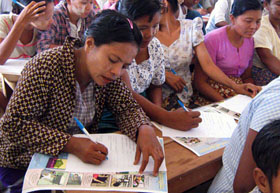Background and Objectives
Background

The Community Based Disaster Risk Reduction (CBDRR) in the Cyclone Nargis affected areas of Myanmar, is a joint project of UNDP and UN-HABITAT, also builds on UNHABITAT role in the on-going post-Nargis response. UN-HABITAT has strongly advocated the notion of “building back better” and understands the challenges associated with making this notion a reality in the Delta region. UN-HABITAT, as Shelter Cluster Coordinator has worked, at a macro level, on standards and guidelines.
Objectives
The overall objective of the project was to enhance basic disaster preparedness of the cyclone-affected communities and integrate disaster risk reduction efforts in some of the key sectors of recovery.
Outputs
Towards this objective, the project will deliver three related outputs:
* Output 1: Community-based disaster preparedness (Main responsibility UNDP)
* Output 2: Capacity development for integrating disaster risk reduction in the rebuilding of human settlements (Main responsibility UN-Habitat)
* Output 3: Awareness generation, Knowledge Networking and Partnerships (Shared responsibility UNDP – UN-Habitat)
Activities
* Set up artisan association groups for training of trainers at various levels.
* Develop a training process for artisans focused on safe rebuilding approaches and techniques.
* Conduct training on Community Based Disaster Risk Management (CBDRM) community association groups, with regard to the selection of artisans for training and the on-the-ground demonstrations for safe rebuilding.
* Conduct demonstrations of safe rebuilding in 100 villages by means of the CBDRM community selected limited number of houses of most venerable people and employing artisan for improvements.
* Development of IEC Materials, manuals and other documents for wider dissemination of information.
* Partnerships with government institutions, UN agencies and coordination with private agencies and other existing organizations for widening the scope of DRR.
Results
* 320 Carpenters from 50 villages were trained in DRR techniques.
* 34 demonstration shelters were built
* 60 people in 20 villages were trained to form Shelter Construction Committees
* 320 Carpentry Kits were distributed _one for every trainee
* 132 shelters in 20 villages were upgraded by the Shelter Construction Committees
* 11,100 Household Guideline (How to build a safer shelter), 3,000 Carpenter Guideline (How to build a safer shelter), 10,500 Poster (Protect our Shelter from Rain, Storm and Flood), 2,500 Village Shelter Committee Manual were disseminated to the various levels.
Development Partners / Partners
Development Partners: DFID
Partners: Ministry of Social Welfare, Relief and Resettlement, Ministry of Construction, UNDP, Early Recovery Cluster partners, NGOs, UN Agencies and relevant local Authorities
- The Project for Emergency Support to Poor and Vulnerable Communities in Ethnic Areas
- A Short Step from Improved WASH to Healthier Communities
- The Programme for Emergency Assistance to Poor and Vulnerable Community in Ethnic Minority Areas and Yangon
- Safe and Sustainable Access to WASH for Rural Communities
- Shelter Recovery Programme – Post Giri Affected Areas
- Shae Thot ‘The Way Forward’
- Land Administration and Management Programme (LAMP) in Myanmar
- Safer Coastal and Urban Communities through DRR in Myanmar
- Disaster Risk Reduction for Safe & Resilient Burmese Coastal Communities
- The Programme for Development and Rehabilitation of Community in Ethnic Minority Area, Myanmar
- Myanmar Climate Change Alliance (MCCA)
- Rebuilding Homes-Rebuilding Lives – Coastal Settlements Sustainable Recovery (CSSR)
- Rebuilding Homes-Rebuilding Lives – Coastal Settlements Support Programme (CSSP)
- Coastal Communities Livelihood Assistance Programme (CLAP)
- Disaster Response & Preparedness – Resilient Coastal Communities and Urban Risk (DRP-CURB)
- Shelter Improvement and Disaster Risk Reduction Project
- Community Water Supply and Sanitation Recovery
- Community Based Disaster Risk Reduction (CBDRR)
- Support to the Coordination of Early Recovery Shelter Interventions-Shelter Cluster Lead
- Semi-permanent Schools in Ayeyarwady Delta in Myanmar / Multi-purpose Schools in Ayeyarwady Delta in Myanmar






































